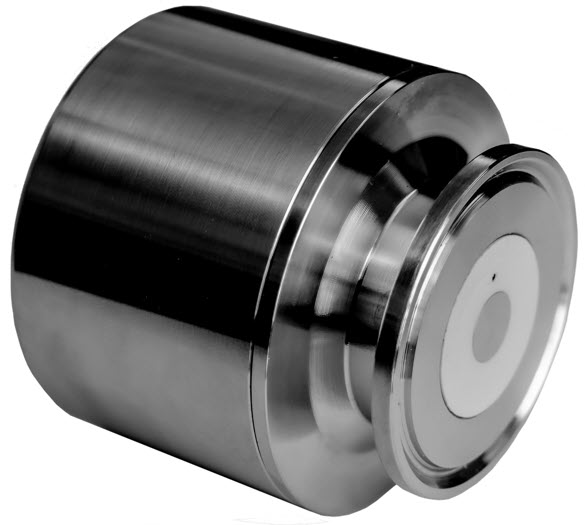Bacterial contamination in Food & Beverage [Download this white paper as PDF file]
In the food and beverage industry, particular attention shall be paid to the hygiene of the production environment, because bacteria and other microorganisms proliferate very quickly. Inside pipelines and tanks, microorganisms can be found free-floating in the liquids ("planktonic" form) or, more commonly, settled on surfaces ("biofilm"). Biofilm is a complex community of microorganisms, mainly bacteria, adhered to a surface by means of extracellular substances (EPS) secreted by the microorganisms themselves. This sessile life form is an excellent survival technique, given the number of strategic advantages it provides, even in food processing plants. And this is the reason why more than 90% of bacteria live in biofilm - not free in the liquid. Due to its structure, biofilm protects microorganisms from disinfectants and other physical attacks. Indeed, chemical diffusion and physical access are strongly limited by the EPS matrix.
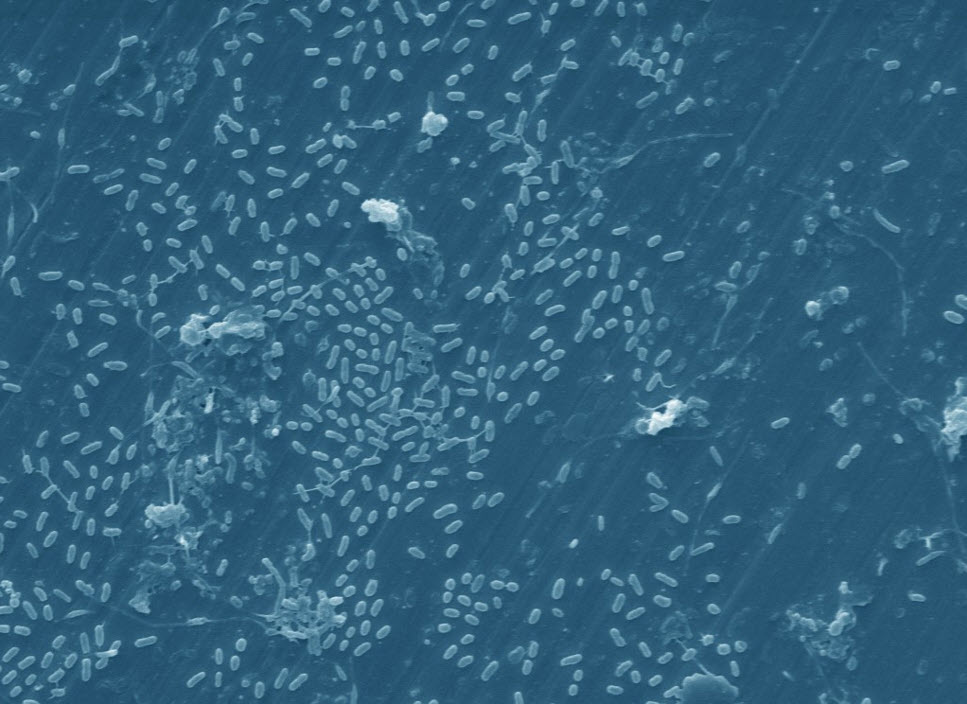
Biofilm communities are usually formed by a wide variety of bacterial species capable of exchanging genetic material and acquiring different phenotypic characteristics, through a range of mechanisms usually known as "horizontal gene transfer". Bacteria within biofilm often "collaborate", e.g. modifying the composition of the extracellular polymeric matrix in order to acquire better resistance to antimicrobial agents, or aerobic species consume oxygen creating a favorable environment for anaerobic bacteria. In the food industry, fresh products can suffer from biofilm formation by mixed pathogenic species (Aeromonas hydrophila, Listeria monocytogenes, Salmonella enterica, Vibrio spp. and others). Furthermore, bacteria living within biofilm can cause damage such as corrosion of metal pipes, resulting in significant health and economic issues. Biofilms are capable of adhering to a wide range of materials, with different composition. The processing environment of food industries, including wood, glass, stainless steel, polyethylene, rubber, polypropylene, etc., work well as artificial substrate for these pathogens. Controlling biofilm formation can be extremely difficult, when it comes to the choice of the best strategy.
Thus, accurate methods for the early detection of biofilm are necessary, to evaluate the need and effectiveness of sanitation treatments, to avoid contamination, and to ensure food safety.
Bacteria-related issues in Food and Beverage production
In Food & Beverage production, free-floating bacteria, and even more biofilms, are responsible for a number of issues, including damaged equipment, increased energy costs, food spoilage and outbreaks. With time, biofilms have become more resistant to disinfection in many food industries, such as dairy, meat and poultry processing, brewing, seafood processing and others. As mentioned earlier, biofilm is much more resistant to antimicrobial agents (up to 1000x), compared to free-floating bacteria. Removing it from the surfaces of a food processing plant is not at all an easy task.
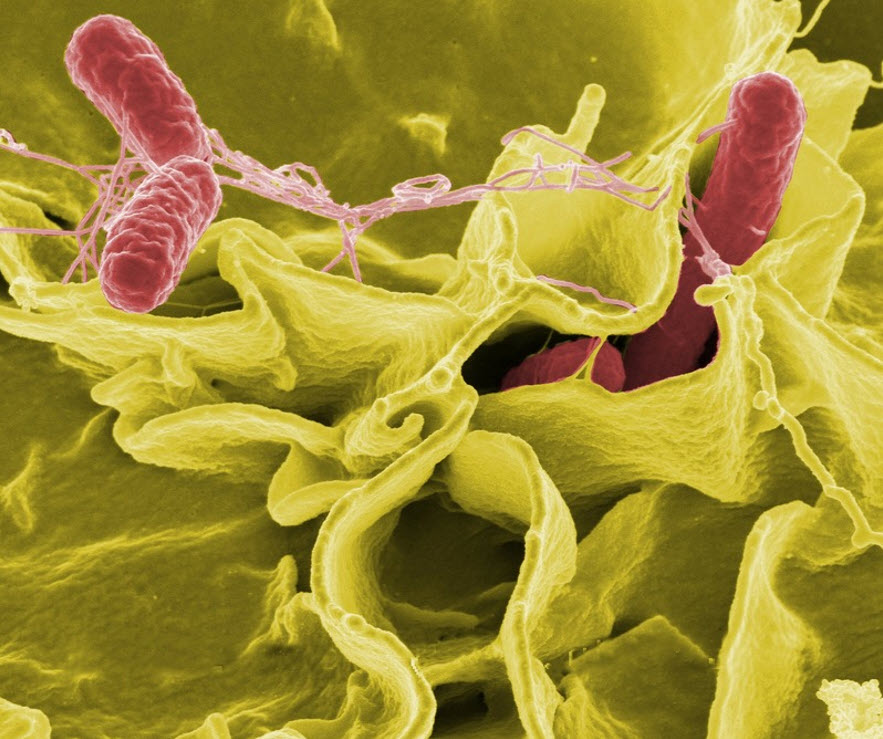
Modern food processing lines are an ideal environment for biofilm to form on food contact surfaces, primarily due to the complexity of manufacturing plants, long production periods, mass product generation, and large growth areas. Many food-borne bacteria, including Listeria monocytogenes, Yersinia enterocolitica, Campylobacter jejuni, Salmonella spp., Staphylococcus spp., Bacillus cereus, and Escherichia coli may, therefore, bind to the contact surfaces in these areas, increasing the risk of bacterial food-borne diseases. As reported by the National Institutes of Health, approximately 80% of bacterial infections in the United States are associated with biofilms.
The food matrix components in processing environments may influence bacterial attachment. Food residuals, such as milk and meat exudates enriched in fats, proteins and carbohydrates, facilitate the growth and proliferation of microorganisms. In order to limit as much as possible microbiological contamination of food production facilities and equipment, hygienic design and proper protocols shall be applied. To this aim, equipment shall be designed preventing gaps, crevices and dead areas, where microorganisms can harbor and grow. This is extremely relevant during production, when microorganisms can grow very quickly under favorable conditions. Biofilms allow bacteria to bind to a range of materials, including rubber, polypropylene, plastic, glass, stainless steel, and even food products, within just a few minutes. The rougher the surface, the easier the bacterial attachment. Then, a mature biofilm can develop within a few days - or even just a few hours. Hence, materials and surface finishing play an important role in biofilm prevention.
Detection methods
The occurrence of several microorganisms, such as Pseudomonas ssp., on food processing systems is commonly due to inadequate hygiene procedures. Fortunately, in the last decade, the F&B industry has benefited from new rapid methods for the evaluation of hygienic condition of food processing surfaces. Different techniques are available to qualitatively and quantitatively evaluate both free-floating bacteria and biofilms - and each one is useful for estimating a peculiar aspect. By considering the complexity and heterogeneity of biofilm structure, the exact objective should be set. The amount of EPS, the total number of bacterial cells embedded in biofilms, or the actual number of living bacteria in biofilms must be considered to be different targets that require distinct approaches. It shall be considered that the biofilm volume is constituted mainly by an extracellular matrix (65-95%), composed mostly of proteins, then polysaccharides (1-2%), DNA molecules (<1%), RNA (<1%) and ions (bound and free). It is possible to read much more about detection of bacteria in a previous white paper.
Laboratory techniques
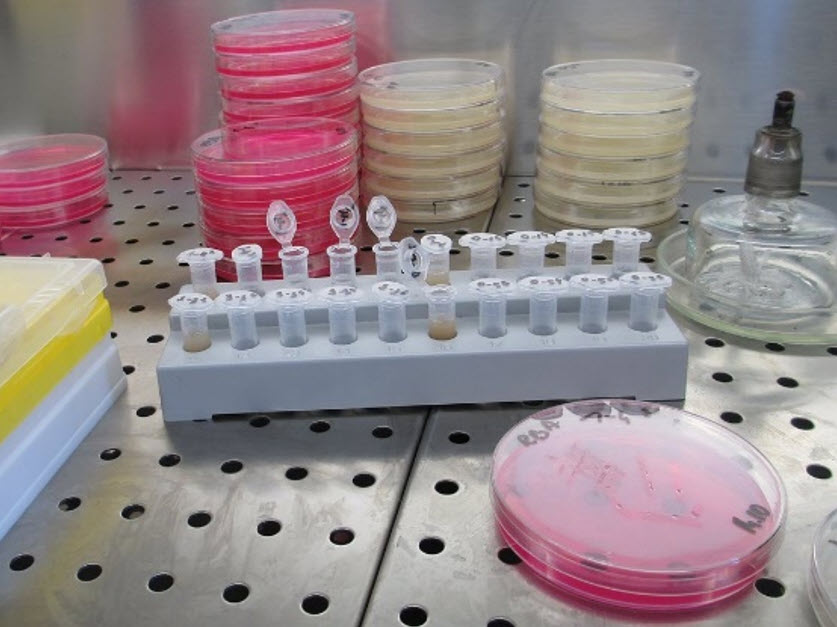
The estimation of the total number of bacteria (total viable count, TVC) is the most widely used technique to quantify the abundance of bacteria in a sample - either of a liquid or from a surface. The main reason is that this technique is easy and requires no special equipment. Serial dilutions of the original sample are prepared, and then plated on agar media. The number of colony-forming units (CFU) that form provides an approximate indication of the bacterial abundance in the sample. The analysis of specific bacteria can be carried out using selected media.
This method has serious drawbacks and limitations. First of all, the sample, either of liquid or of biofilm, may not be representative of the real population. Secondly, in some cases just 1% of the bacteria present in a sample grows on laboratory culturing media. Moreover, in some cases there can be a large number of viable but non-culturable (VBNC) cells, that cannot be detected by means of culturing techniques. All these points may lead to a large underestimate.
Applying flow cytometry coupled with selected fluorophores may represent a valid alternative, since with this technique it can be possible to distinguish total, dead, and VBNC cells.
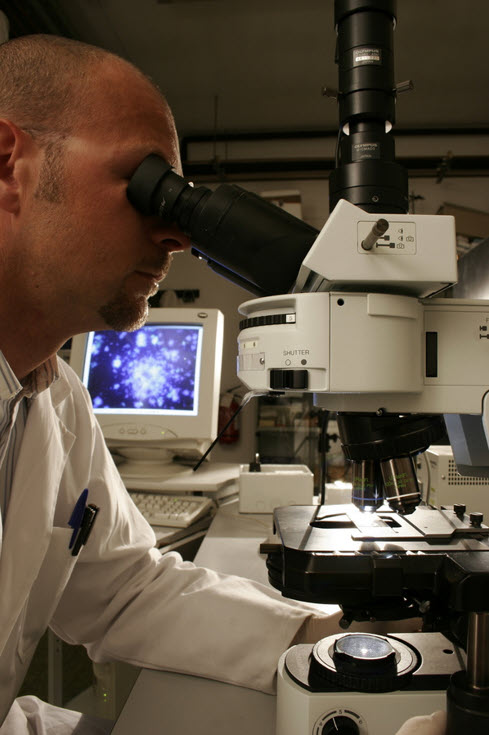
Microscopy is another technique widely used in laboratory, to study samples from the process. Epifluorescence microscopy applied to cells marked with a fluorescent dye provides a wide variety of information. Various cell structures can be targeted, in particular cell membrane, nucleotides, and proteins.
Other more advanced techniques, like confocal laser scanning microscopy (CLSM), mass spectrometry, electron microscopy, Raman spectroscopy can be used, to obtain complementary information.
The Live/Dead method, suitable for use in epifluorescence microscopy, CLSM, fluorometry, and flow cytometry is based on employing two different fluorescent stains. The first, green dye crosses all bacterial membranes and binds to DNA of both Gram-positive and Gram-negative bacteria. The second, red dye crosses only damaged bacterial membranes. Live bacteria fluoresce in green and dead bacteria fluoresce in red. The efficiency of both stains is conditioned by some factors, such as the binding affinity of reagent to cells, physiological cell state, reagent concentration, temperature and incubation time.
Nucleic acid-based identification systems, commonly known as molecular techniques, can significantly improve the sensitivity, specificity, and speed of microbial assays. These methodologies are highly reliable and allow for rapid detection of pathogens in food. Among these, the most widely known is for sure PCR, that allows to amplify and detect a specific DNA sequence - even if it is present as a single copy. Thus, PCR can theoretically detect even a single pathogen in a sample.
Real time PCR assays have also been developed for the rapid detection and quantification of specific bacteria.
Other techniques to quantify the DNA are available, each one with its own advantages and disadvantages, as well as different sample volume, equipment and requirements.
UV spectrophotometry using absorbance at 260 nm has been the method of choice for quantifying DNA and RNA for decades. It is simple and convenient to use because no further sample treatment or reaction with other substances is required. The absorbance of DNA samples at 260 nm is currently most often measured using a microvolume spectrophotometer, but a cuvette spectrophotometer or microplate reader can also be used. However, UV spectrophotometry is not very specific, since it measures all nucleic acids and it is quite sensitive to contaminants. The use of fluorescent dyes allows DNA quantification with a much higher sensitivity (up to 100x) than measuring the absorbance of the DNA itself. Moreover, specific dyes can be used to stain only specific types of nucleic acid, thereby increasing the specificity of the quantification and reducing the effect of contaminants. The measurement of fluorescence is performed using a microplate reader or a single tube fluorometer. It shall be noted that fluorescence-based methods are more expensive than measuring absorbance at 260 nm, and the preparation of a standard curve is often required.
A more advanced approach to study the whole microbial community that can be found in a production line or in a final product is based on metagenomics. This category includes many different techniques that allow to sequence the genome of all microorganisms present in the same sample, identifying them down to the species level, in the best case. Many of these organisms can be difficult to cultivate and identify in laboratory, and metagenomics helps to overcome this problem. Metagenomics does not provide quantitative information about each group of microorganisms, but only their relative abundance. Once these techniques were used in scientific research only but, thanks to the drop in their cost over the last few years, they became affordable even for industrial applications.
Field techniques
Rapid methods based on microbial growth and metabolism have been developed for field applications, using the principles of adenosine triphosphate (ATP) bioluminescence. This organic compound provides the energy required by many processes in living cells (including microorganisms), so it is often referred to as the "molecular unit of currency" of intracellular energy transfer. The assay can detect the amount of ATP on a surface in a food processing system, as well as in food samples. ATP reacts with the luciferin-luciferase enzymatic complex, which transforms the chemical energy to light, that can be measured by a luminometer. The result is expressed in Relative Light Units (RLU). The higher the amount of ATP in a sample, the higher the light output expressed in RLU.
Since this method is fast, and it requires just a small and practical portable device, it has gained a significant user base in the food industry.
ATP bioluminescence method is commonly considered to overestimate the real microbiological contamination, since in some cases even dead cells could be detected. Moreover, it has a low reliability on naturally contaminated surfaces and it does not give specific information about the microorganisms, thus it is commonly applied on clean surfaces.
It shall be considered that rapid chemical tests are not a direct substitute for microbiological tests, but they provide complementary information that should be used as part of an integrated strategy.
A fresh new approach is offered by ALVIM Biofilm Sensors. Monitoring bacterial growth on surfaces on line and in real time, since its first phase, ALVIM probes allow to prevent biofilm-related issues, including the microbiological contamination of production lines and final products. At the same time, this Technology makes possible to verify the efficacy of sanitation treatments, as discussed in specific application cases related to food production, soft drinks, and mineral water bottling.
Sanitation methods
To prevent the dangerous bacterial-related issues mentioned above, in the food processing industry it is necessary to implement strict hygiene and control procedures. With the development of new products and new technologies and exchanges between countries, the risk of outbreaks of food-borne diseases is increasingly high.
The Hazard Analysis and Critical Control Points (HACCP) system and good manufacturing practices have been developed to ensure food safety and quality. As discussed in a previous white paper, bacterial biofilms are not directly mentioned in the most HACCP systems employed in food processing facilities - and this is a serious lack, since most of the bacteria that can be found in a process live in biofilm.
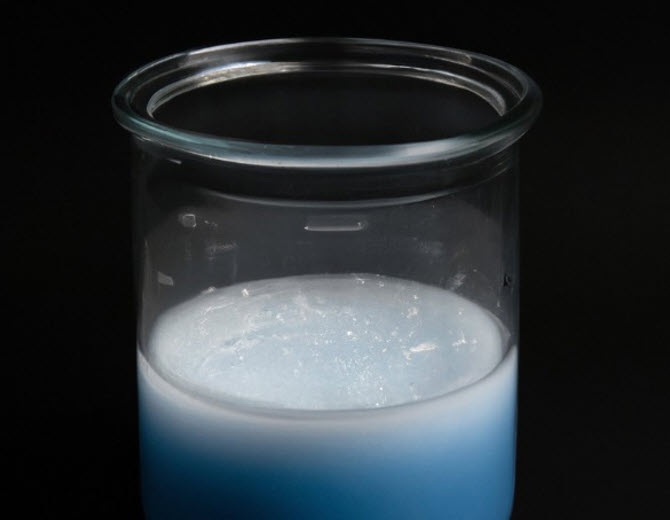
The most widely adopted strategy for controlling bacterial proliferation in Food & Beverage production is chemical sanitation, that combines detergents and disinfectants.
Alkaline and acid detergents eliminate organic and inorganic residuals from surfaces. Disinfectants reduce spoilage microorganisms, and decrease or eliminate pathogens, to safe levels.
The most commonly used disinfectants in the food industry are peroxides (peracetic acid and hydrogen peroxide), sodium hypochlorite, quaternary ammonium compounds (QAC), amphoteric compounds, aldehydes (formaldehyde, glutaraldehyde, paraformaldehyde), and phenolics. This product list is still the same since many years. More recently, alkyl amines and chlorine dioxide have been incorporated into disinfection programs.
Peracetic acid (PAA) has been widely used by the food industry to control bacterial proliferation. Its antimicrobial effect is attributed to the oxidation of thiol groups in proteins, disruption of membranes, and damage to bases in DNA. Its use has been shown to increase the sensitivity of bacterial spores to heat. The efficacy and environmental safety of peracetic acid make it an attractive disinfecting agent for industrial use.
In the food industry, sodium hypochlorite (NaCIO) is one of the most widespread disinfectants; it reacts with a wide range of biological molecules, such as proteins, amino acids, lipids, peptides and DNA. Its reaction produces both hypochlorous acid (HOCl) and hypochlorite ion (ClO-), which are strong oxidizing agents that kill cells due to their ability to cross the cell membrane. However, sodium hypochlorite has some disadvantages (range of pH and temperature, by-products, etc.) that often make users prefer other products available on the market.
Quaternary ammonium, or its compounds, such as benzalkonium chloride, cetrimide, didecyldimethylammonium chloride and cetylpyridinium chloride, are cationic detergents. They reduce surface tension and form micelles to lead to dispersion in a liquid. They interact not only with the cell membrane of the bacteria, but also with the yeast one. Their hydrophobic activity makes them effective against viruses too. Inside microbial cells, QACs interact with intracellular targets and bind to DNA. However, their efficacy is still questioned given the appearance of relatively high resistance in Listeria monocytogenes, Staphylococcus, and Pseudomonas isolated from food products and food processing environment.
In the last few years, enzymatic treatments have been increasingly used. These substances disrupt the EPS matrix of biofilm, thus increasing the effectiveness of traditional disinfectants. Among their advantages there are also the low-toxicity and biodegradability, but the cost and technical requirements (temperature, contact time) are somehow limiting.

The use of bacteriophages to eliminate bacteria in industrial applications has been studied for decades. Bacteriophages are specific viruses that attack bacteria only. They are specific to different serotypes or strains of microbial species, and are obligate parasites with a genetic parasitism. Indeed, bacteriophages exploit bacterial cells to replicate themselves and, when the process is complete, they destroy the host cell. This means that a bacteriophage infection can destroy an entire bacterial colony. In the last few years, the US FDA approved bacteriophages to combat the presence of L. monocytogenes in foods.
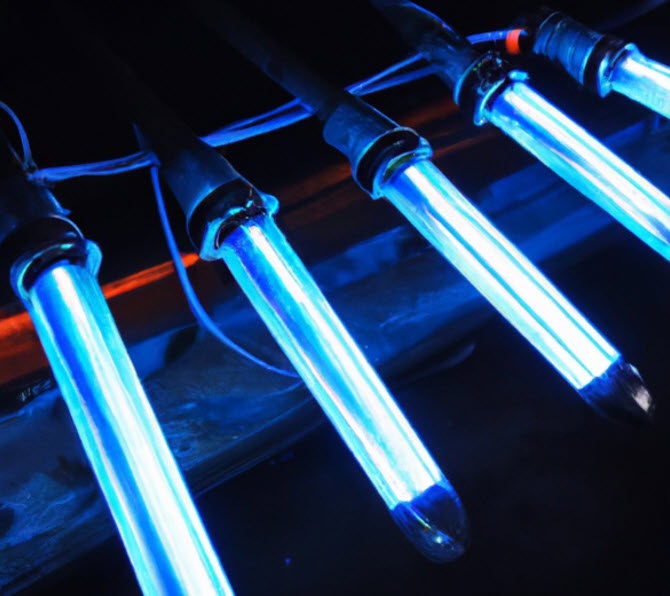
The application of UV radiation for sterilization has been an accepted practice since the mid-twentieth century. It was first used in medicine to sterilize tools. UV can be divided into various categories, one of them is the short wavelength category (UVC), and it is considered germicidal. Indeed, at certain wavelengths, UV is harmful to bacteria, viruses and other microorganisms. In particular, at a wavelength of 254 nm UV destroys the molecular bonds of the DNA, making microorganisms harmless, preventing their growth and reproduction. Microorganisms have poor UV protection and they cannot survive prolonged exposure.
The effectiveness of the radiation depends on many factors: exposure time, variations in the power of UV source which affects the electromagnetic wavelength, presence of particles which can protect microorganisms from UV, and the specific resistance of microorganisms. In many systems the effectiveness is increased by repeated circulation of water under UV source, to increase the likelihood of ultraviolet radiation hitting microorganisms, and by irradiating them multiple times.
UV irradiation is typically used to sterilize clean water, such as drinking water and distilled water. Even water used in the food industry could be effectively sterilized by UV. However, this technique cannot be considered as effective as biocides, especially when it comes to biofilm. Indeed, UV irradiation is applied to planktonic bacteria, and may therefore not be a useful tool for eliminating biofilm, that may form far from the UV source and therefore may not be affected by the treatment.
Conclusions
Biofilms have become a major concern in the food industry over the last 30 years. This topic is prominent due to the potential for contamination of food from biofilms, since they are up to 1000-fold more resistant to sanitation than their planktonic counterparts, and they are responsible for more than 20% of food poisoning cases. Many bacterial species have the ability to form biofilm, and in this way they increase their resistance to hostile environments, antibiotics and disinfectants. For these reasons, the food industry shall put in place cleaning and disinfection protocols aimed at preventing biofilm, eliminating it as soon as it starts to form. Indeed, once mature it can be virtually impossible to get rid of this microbial layer. The new technologies currently available for biofilm detection, in particular those that make possible to detect biofilm on line and in real time, should be applied in the food industry wherever possible, to get an early warning and apply the most appropriate treatment in a timely way.
|
Do you have biofilm-related issues?
|






